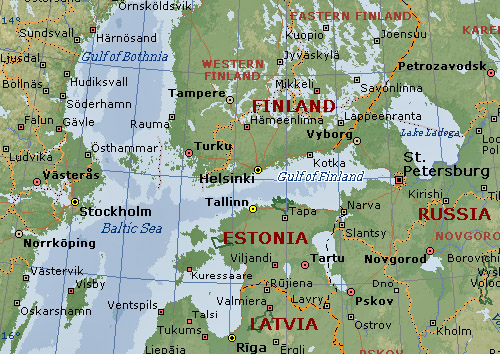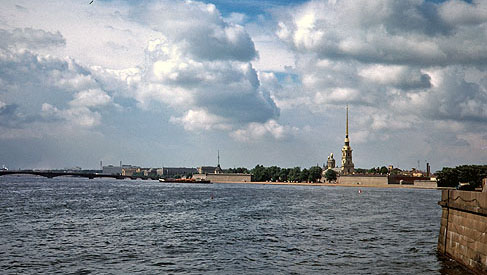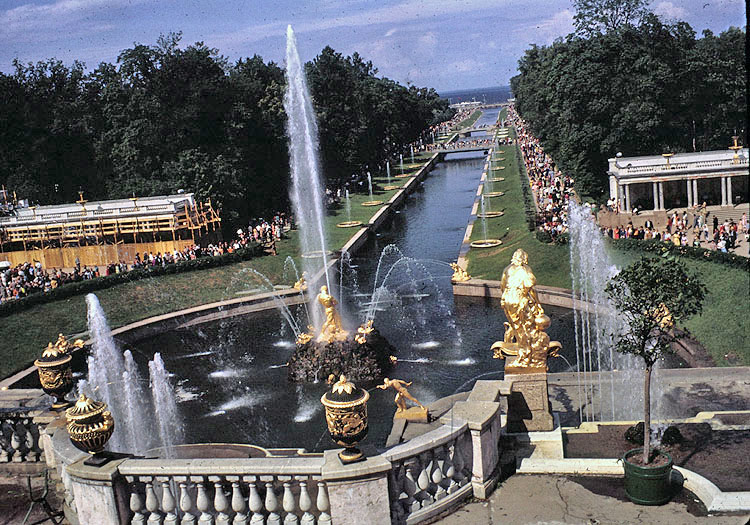The Baltic Sea, located in Northern Europe, extends from the Scandinavian Peninsula eastward to Finland, Estonia and Russia. Some parts (gulfs and bays) freeze over during the winter, but the main part of the Baltic does not freeze. Still, in general, in the Baltic region, winters are long and cold, whiles summers can be short but comparatively warm.
The Gulf of Finland is the easternmost part of the Baltic Sea, almost three hundred miles long, located between Finland (Helsinki), Estonia (Tallinn) and Russia (St. Petersburg)--all three capital cities were once part of the Russian Empire. The main rivers flowing into the Gulf are the Narva and Neva. The Gulf of Finland does freeze over from December through March.

![]()
The Narva River is one of the main rivers flowing into the Gulf of Finland. This was the site of Peter the Great's first attempt to build a "window to the West." In August 1700, at the start of the Great Northern War between Russia and Sweden, Peter moved to capture the port of Narva with his army of approximately 35,000 men. While the siege of the town was underway, King Charles XII of Sweden, one of history's greatest military leaders, arrived on the scene in November with his army of about 8,000 men. Peter the Great left his troops to meet the approaching Russian reinforcements and urge them along, but it was too late. On 20 November 1700, in a blinding snowstorm, the Swedes attacked the center of the Russian army. The rout was on, and the Russian army disintegrated; thousands died, over fifteen thousand surrendered. Swedish losses were about 600.
The Swedes had won the battle, but they were going to lose the Great Northern War (by 1721). More importantly, Peter founded St. Petersburg as his "window to the west" in 1703, and then in 1704 captured Narva to solidify his hold on the eastern Baltic.
The Neva (Нева) River is the other main river flowing into the Gulf of Finland. It flows from Lake Ladoga through Saint Petersburg for a distance of only about 65 miles. Although it is a very short river, it is one of the largest rivers in Europe in terms of average discharge volume. The Neva delta, with all of its channels, canals and islands, is the site of St. Petersburg.

Peter-Paul Fortress on the Neva, guarding the city of St. Petersburg
Peter the Great, inspired by the city layout of Amsterdam, founded St. Petersburg (Санкт-Петербург), aka Petrograd (Петроград from 1914 to 1924) or Leningrad (Ленинград from 1924 to 1991), on 27 May 1703 as his "window to Europe." It then became his capital city, and he ordered all Russian nobles to move to St. Petersburg from Moscow, or if they did not not move, at least they had to maintain a house there.
The problem was that the site of the new Russian capital city was a swamp, or more politely a "marsh," subject to frequent flooding and the bitter extremes of winter and summer weather. Construction of any stone buildings basically ceased throughout the country while St. Petersburg was being built. Everyone traveling to the city had to also bring rocks. Embankments had to be built up; islands raised; and canals constructed to confine the flow of the river and drain the swamp. Thousands of serfs and prisoners-of-war who were forced into the construction of the city perished of malaria and the extremes of the climate. Their bodies were dumped into the construction sites; hence the nickname that St. Petersburg was a "city built on bones."
Flooding has been a repeating problem over the centuries; it still is. One of the worst floods occurred in November 1824 when the water level rose about twelve feet above normal. Canals and islands disappeared into one giant river. Over five hundred people died. This particular flood was the setting and inspiration for Pushkin's poem, The Bronze Horseman.

St. Petersburg winter scene
During the imperial period, the most important Russian naval base, and home of the Baltic Sea Fleet, in the Baltic region was at Kronstadt (Кронштадт) on the island of Kotlin about 25 miles to the west of St. Petersburg. Peter the Great had founded Kronstadt in 1704 to secure his control of the Gulf of Finland and to protect St. Petersburg from any attack.

View of Kronstad with one of the old forts guarding the harbor entrance
One of the very darkest pages in the pages of Soviet history--and there are many dark pages there--occurred in March 1921. In late February 1921, sailors of the Kronstadt garrison rebelled against the Bolshevik regime. The sailors had been among the most supportive of the Bolshevik seizure of power in October 1917, and they had fought for the Bolshevik regime throughout the civil war. But in 1921, they were tired, poorly fed, and angry. They seized control of the island, called for free elections to the soviets, an elimination of the Bolshevik monopoly of political power and an end to war communism and the forced grain requisitions.
The revolt occurred at the same time that the Bolsheviks were holding their congratulatory Tenth Party Congress in Petrograd. Lenin reacted with ruthlessness and ordered the island stormed and the rebels exterminated. There was an urgency to gain control of the fortress before the frozen sea melted, which would have made it inaccessible to a land assault. Trotskii and Marshal Tukhachevskii, head of the Red Army, ordered repeated assaults of Red Army troops and communist party volunteers across the ice towards the fortress. Many soldiers were forced onto the ice at gunpoint, and some actually joined the rebellion. Casualties were high on both sides, but after repeated assaults, the Red Army was able to reach the island and crush the rebellion by March 18.Some rebels escaped across the ice to Finland; most who survived were executed or sent to prison camps.
For further information I recommend:
- Kronstadt, 1917-1921: The Fate of a Soviet Democracy, by Israel Getzler, Cambridge University Press 2002
- Kronstadt Uprising (Seventeen Moments in Soviet History)
Peterhof (Петергоф, Peter's Palace)--called Petrodvorets from 1944 to 1997--sometimes called the "Russian Versailles"--is the elaborate summer palace and gardens that Peter the Great had constructed between 1714 and 1725 on a bluff overlooking the Gulf of Finland, southwest of St. Petersburg by about 12 miles. Each of the ensuing tsars expanded the palaces and gardens. During World War II, the Germany army captured Peterhof and systematically, looted, burned and destroyed much of the palace, buildings, fountains and gardens. Restoration is ongoing.

The Sea Channel (Morskoi Kanal, Морской канал) and Samson Fountain (Фонтан «Самсон»)looking west to the Gulf of Finland.